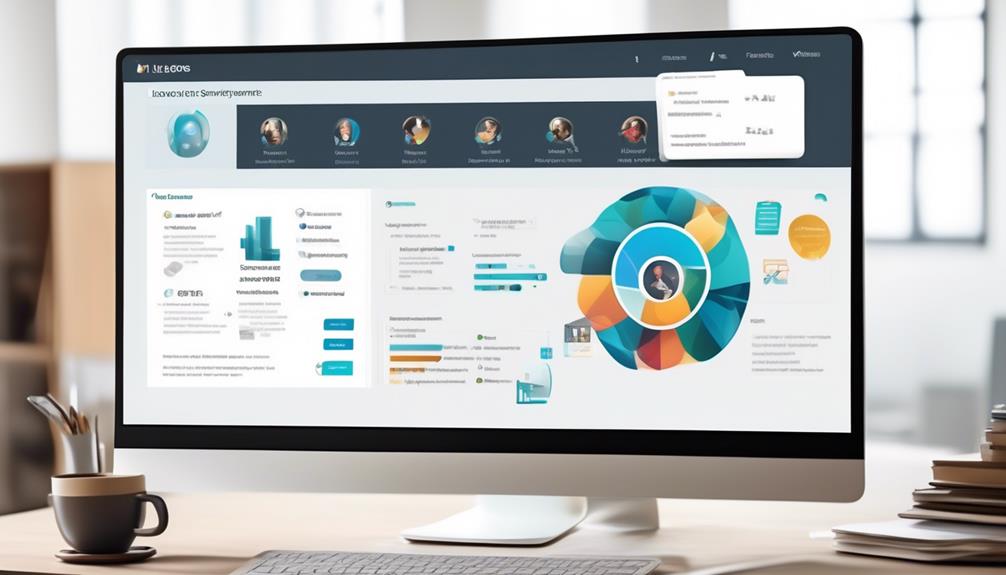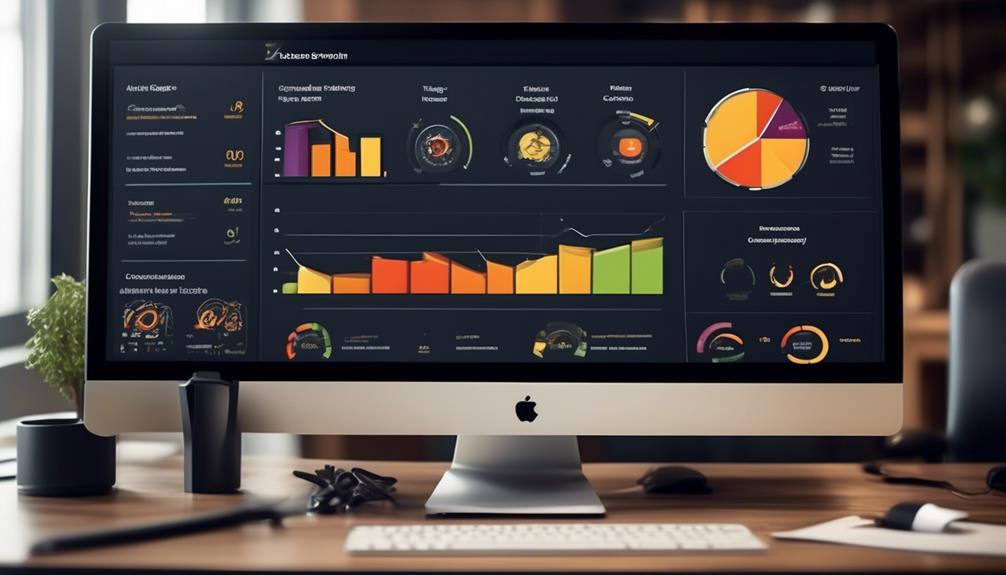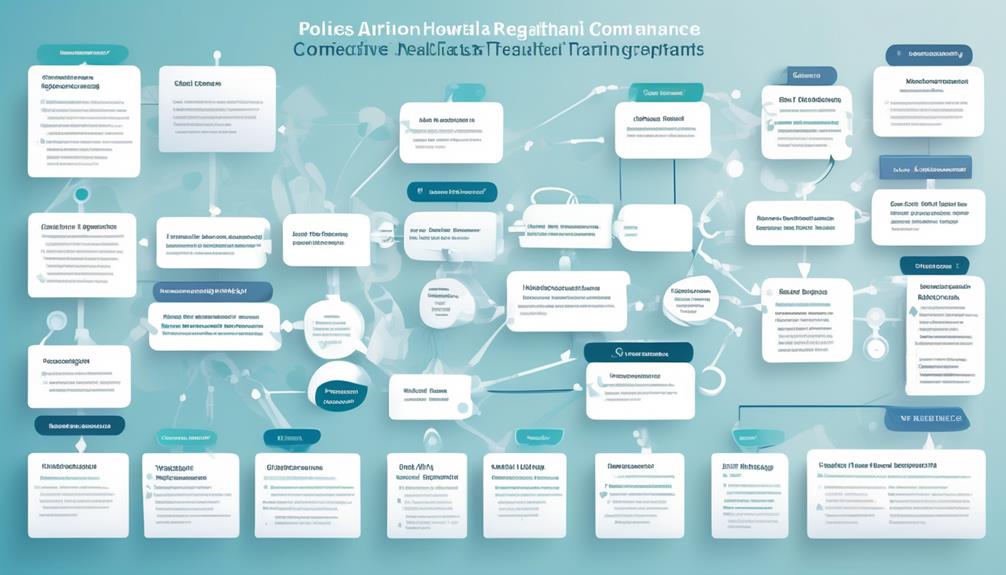Compliance Hub
7 Key Tips for Effective Compliance Training Programs
Frustrated with dry compliance training? Discover seven key tips to transform your program and engage employees like never before.

It is commonly viewed that compliance training often seems boring and lackluster; however, it doesn’t need to be so. To ensure compliance training programs are effective, there are seven essential tips that can significantly boost both engagement and the retention of information.
From understanding the audience to embracing mobile learning, these tips are essential for creating a successful compliance training program.
So, how can these tips be implemented to ensure that employees not only understand but also internalize the compliance requirements of the organization?
Key Takeaways
- Tailoring training content to align with employees’ daily work activities and challenges is crucial for effective compliance training programs.
- Incorporating real-life scenarios and case studies helps employees connect with compliance issues and fosters a deeper understanding of compliance requirements.
- Diversifying training methods by incorporating visuals, audio elements, gamification, and informative videos caters to different learning styles and enhances engagement and knowledge retention.
- Managing training effectively by breaking down complex topics, providing ongoing support and resources, and embracing mobility and accessibility ensures employee engagement and understanding.
Know Your Audience
Understanding the educational backgrounds and professional experiences of our audience is crucial when developing compliance training programs. Tailoring the training content to align with the daily work activities and challenges of our employees is essential for effective learning. By incorporating real-world scenarios, case studies, and storytelling into our online compliance training, we can make the content more engaging and relatable for our audience. This approach helps in capturing the attention of our employees and making the training more impactful.
In addition, we recognize the importance of accommodating different learning styles within our audience. By incorporating a variety of learning methods and preferences, we can ensure that the training caters to everyone, regardless of their preferred learning style. This inclusivity fosters a more effective learning environment and enhances the overall understanding and retention of compliance training content.
Moreover, ensuring mobile accessibility of our compliance training is paramount. By providing flexibility and convenience, our employees can engage with the training at their own pace and schedule, ultimately leading to better participation and comprehension.
Keep It Real

To ensure the effectiveness of compliance training programs, it is essential to incorporate real-life scenarios and case studies that resonate with our employees’ daily work experiences. By integrating these elements into our compliance program, we create a learning environment that is relevant and relatable to our employees. Real-world scenarios and case studies provide practical examples of compliance issues that employees may encounter in their roles, making the training more engaging and impactful. This approach fosters a deeper understanding of compliance requirements and empowers employees to apply their knowledge effectively in their day-to-day activities.
Benefits of Real-life Scenarios in Compliance Training Enhanced Relevance Increased Engagement Practical Application
Incorporating real-world scenarios and case studies into our training not only makes the content more engaging but also creates a risk-free environment for employees to connect with compliance issues. It humanizes the training experience, fostering an emotional connection and enabling employees to see the real-world benefits of compliance in their work. By keeping the training real and relatable, we can ensure that our compliance program has a lasting impact on our employees’ understanding and application of compliance principles.
Mix It Up
Let’s talk about the importance of mixing up the content in compliance training programs.
When we vary the training delivery methods and incorporate visuals, audio elements, gamification, and informative videos, we engage learners more effectively.
Varied Content
Incorporating a mix of content types into compliance training programs can significantly enhance engagement and knowledge retention. By utilizing visuals, audio elements, gamification, simulations, and informative videos, the program can cater to different learning styles and preferences, making the training more effective.
This varied content approach helps to avoid monotony and keeps the training interesting and diverse. It’s crucial to address all potential needs and preferences in the education and training programs to ensure effectiveness.
The diverse content not only enhances engagement but also improves knowledge retention, ensuring that employees grasp and remember the compliance information. Therefore, by mixing up the content and accommodating different learning styles, compliance training can be more effective in conveying essential information and ensuring understanding.
Engage Learners
After incorporating a mix of content types into compliance training programs to enhance engagement and knowledge retention, engaging learners through a variety of learning methods becomes imperative. To effectively engage learners and accommodate different learning styles in compliance training, we recommend the following strategies:
- Incorporate a variety of learning methods, such as visuals, audio elements, gamification, and simulations.
- Use case studies, real-world scenarios, and storytelling to make compliance training relevant and engaging.
- Break content into short, bite-sized modules to make information easily digestible and retainable for employees.
- Provide flexibility with mobile learning to enable access to training anytime and anywhere.
Avoid Overwhelming

To prevent overwhelming learners during compliance training, it’s essential to break down complex topics into smaller, digestible modules and provide regular breaks for effective content absorption.
When designing our compliance training program, we aim to ensure that the material is presented in a clear and concise manner, avoiding technical jargon that may hinder understanding. By using language that’s accessible to all employees, we can help them grasp the key concepts without feeling overwhelmed.
Additionally, incorporating interactive elements such as quizzes, discussions, and practical exercises into the training sessions can keep employees engaged and prevent them from passively absorbing information, which can lead to feeling overwhelmed.
We understand the importance of offering ongoing support and resources to our employees as they navigate through the training program. This support not only reinforces their understanding but also provides opportunities for clarification and further learning.
Embrace Mobility

As we focus on the next aspect of our compliance training program, we recognize the need to adapt to the modern learning landscape, particularly by embracing mobility. Embracing mobility in our compliance training program is crucial for meeting the diverse needs of our employees and ensuring their engagement and understanding of laws and regulations. Here are four key reasons why we need to embrace mobility in our training program:
- Flexibility: Embrace Mobility allows employees to access training anytime and anywhere, catering to their busy schedules and diverse work environments.
- Device Diversity: It provides flexibility for learners to access compliance training on different devices, ensuring that they can choose the most convenient option for them.
- Seamless Accessibility: Embrace Mobility supports seamless switching between devices for convenient accessibility, enabling employees to pick up their training right where they left off.
- Enhanced Engagement: It enhances engagement and knowledge retention by meeting learners where they are, ensuring that the training material is easily accessible and consumable.
Embracing mobility enhances the accessibility and convenience of our compliance training, ultimately leading to a more effective and impactful training program.
Utilize LMS

We highly recommend integrating a Learning Management System (LMS) into our compliance training program to centralize data storage and streamline training management and tracking processes. Utilizing an LMS can greatly enhance the efficiency and effectiveness of our training program. The LMS serves as a centralized platform for the development and implementation of a multifaceted educational and training program that focuses on successful compliance training.
By leveraging an LMS, we can easily store training records, competencies, and certificates, allowing for convenient retrieval when needed. Additionally, the LMS provides access to real-time status, training history, and future compliance training schedules, enabling us to stay informed and proactive in our training initiatives. Furthermore, the LMS streamlines training management and tracking processes, making it easier to monitor progress and ensure that all employees receive the necessary training.
Benefits of Utilizing an LMS Centralized data storage Streamlined training management and tracking Convenient retrieval of training records
Incorporating an LMS into our compliance training program is a crucial step towards creating a well-structured and efficient training environment.
Monitor Progress

As we monitor progress in compliance training programs, we focus on tracking employee engagement, analyzing training data, and identifying areas for improvement.
By regularly tracking and analyzing employee progress, we can gain valuable insights into the effectiveness of the training and identify areas where additional support may be needed.
This proactive approach allows us to adjust training content and delivery to better meet the needs of our employees.
Tracking Employee Engagement
How can we effectively track employee engagement to monitor progress in compliance training programs?
It’s crucial to employ various strategies and tools to ensure that employees are actively participating in and benefiting from compliance training. Here are four key methods to track employee engagement and monitor progress in compliance training programs:
- Utilize analytics to measure participation and completion rates.
- Monitor feedback and engagement levels to gauge employee satisfaction.
- Implement surveys and polls to gather direct input from employees regarding the training programs.
- Track the impact of compliance training on workplace behavior and decision-making through training records and observation.
Analyzing Training Data
To effectively monitor progress in compliance training programs, we analyze training data to track completion rates and participation levels. We also measure knowledge retention and improvement. Additionally, we identify areas for improvement through compliance incidents and violations.
In order to evaluate the effectiveness of the training program, we collect feedback from learners and supervisors. By examining training data, we can gain valuable insights into the efficacy of the educational and training program. This enables us to make data-driven decisions to enhance it.
Furthermore, analyzing training data allows us to assess the impact of compliance training on the performance of affected employees. This ensures that the program aligns with organizational goals.
This comprehensive approach to analyzing training data enables us to continuously improve and optimize our compliance training programs. Ultimately, this leads to a more informed and skilled workforce.
Identifying Areas for Improvement
Regularly assessing and evaluating the effectiveness of our compliance training program allows us to identify areas for improvement and make informed adjustments. To ensure mastery in this area, we recommend the following strategies:
- Set measurable goals and benchmarks to monitor progress in compliance training programs.
- Keep track of completion rates, participation levels, and feedback from learners and supervisors.
- Use data and feedback to make informed adjustments and enhancements to the training program.
- Continuously review and update training content based on the identified areas for improvement.
Frequently Asked Questions
How Do You Make Compliance Training Effective?
We make compliance training effective by:
- Tailoring courses to our audience’s needs
- Using real-world scenarios and storytelling to foster emotional connections
- Incorporating various training methods such as visuals, audio elements, and gamification
Additionally, we employ a microlearning approach by:
- Breaking content into short, bite-sized modules
To enhance efficiency, we utilize a Learning Management System (LMS) to:
- Centralize training data
- Streamline management processes for efficient training delivery and progress tracking.
What Are the 7 Elements of a Compliance Program?
The 7 elements of a compliance program include:
- Written policies
- A compliance officer
- Effective training
- Clear communication
- Monitoring and auditing
- Disciplinary measures
- Response and prevention strategies
These elements form a comprehensive framework for ensuring adherence to regulations and ethical standards within an organization.
Each element plays a crucial role in promoting a culture of compliance and minimizing the risk of non-compliance.
What Are the Main Points of an Effective Compliance Program?
We take compliance training seriously. Our main points for an effective program include:
- Understanding the audience
- Making training relevant through real-world scenarios
- Incorporating variety in methods
- Adopting a microlearning approach
- Utilizing mobile learning
These elements are crucial for ensuring engagement, relevance, and effectiveness in our compliance training program.
What Five 5 Factors Must a Compliance Plan Include?
We believe that a compliance plan must include:
- Legal and regulatory requirements
- Policies and procedures
- Training and education
- Monitoring and reporting
- Enforcement and discipline
This ensures that employees understand their compliance responsibilities, follow clear policies and procedures, are equipped with necessary knowledge and skills, and face consequences for violations.
These factors are crucial for a comprehensive and effective compliance plan.
Conclusion
In conclusion, effective compliance training programs are essential for ensuring workplace adherence to regulations.
By understanding our audience, incorporating diverse training methods, and embracing mobile learning, we can enhance engagement and knowledge retention.
Let’s mix it up, keep it real, and avoid overwhelming our employees with information overload.
With these key tips, we can create a compliance training program that truly resonates and makes a lasting impact.
Randy serves as our Software Quality Assurance Expert, bringing to the table a rich tapestry of industry experiences gathered over 15 years with various renowned tech companies. His deep understanding of the intricate aspects and the evolving challenges in SQA is unparalleled. At EarnQA, Randy’s contributions extend well beyond developing courses; he is a mentor to students and a leader of webinars, sharing valuable insights and hands-on experiences that greatly enhance our educational programs.
Compliance Hub
8 Best Tips for ISO 9001 Manufacturing Compliance
Obtaining ISO 9001 compliance in manufacturing is made easier with these eight essential tips that drive operational efficiency and continuous improvement.

Maintaining compliance with ISO 9001 in the manufacturing industry is broadly recognized as a challenging endeavor. Nonetheless, it may come as a revelation that there exist eight essential tactics which significantly ease this challenge and ensure success. By implementing these key strategies, companies are able to not just achieve and maintain compliance with ISO 9001, but also enhance their overall quality management systems.
These tips cover everything from top management commitment to celebrating certification achievement, and they play a crucial role in driving continuous improvement and operational efficiency.
Key Takeaways
- Engage with detailed specifications and criteria outlined in the ISO 9001 standard to ensure compliance.
- Establish and maintain documented information defining the quality management system, including policies, procedures, and records required by the standard.
- Build an internal auditing process to evaluate compliance and regularly review and improve the quality management system.
- Thoroughly document each step of the process, regularly review and improve the process, and maintain ISO 9001 certification.
Understanding ISO 9001 Requirements
Understanding ISO 9001 requirements involves actively engaging with the detailed specifications and criteria outlined in the standard to ensure compliance with the quality management system. ISO 9001 sets out the criteria for a quality management system and is based on a number of quality management principles including a strong customer focus, the involvement of top management, and continual improvement. Achieving compliance with ISO 9001 involves a thorough understanding of these principles and how they apply to the organization’s processes.
To meet ISO 9001 requirements, it’s essential to establish and maintain documented information that defines the quality management system and its processes. This includes documented policies, procedures, and records required by the standard. Additionally, building an internal auditing process is crucial for evaluating the organization’s compliance with ISO 9001 requirements. Adequate preparation, such as conducting internal audits and management reviews, increases the likelihood of achieving ISO 9001 certification.
Regularly reviewing and improving the quality management system is vital to maintain ISO 9001 certification, ensuring ongoing compliance with the standard’s requirements and standards.
Establishing a Quality Management System

When establishing a Quality Management System, there are three key areas to focus on: documenting processes, ensuring compliance, and continuous improvement.
Documenting processes involves systematically recording each step of the internal audit process. This is important for creating a clear and standardized approach to audits, ensuring consistency and accuracy.
Ensuring compliance requires the involvement of experienced auditing teams. These teams are responsible for conducting audits and ensuring that all processes and activities meet the requirements set forth by ISO 9001. To assist in this process, quality assurance tools like checklists and flowcharts can be utilized to ensure that all necessary steps are followed and that nothing is overlooked.
Continuous improvement is an ongoing effort to stay updated on ISO 9001 requirements and adjust the process accordingly to maintain compliance. This involves regularly reviewing and updating documented processes, training employees on any changes, and seeking feedback from stakeholders to identify areas for improvement.
Documenting Processes
To establish a robust Quality Management System, meticulous documentation of processes is essential to ensure comprehensive adherence to ISO 9001 manufacturing compliance.
When documenting processes, it’s crucial to:
- Establish clear and comprehensive documentation for each step of the internal audit process, ensuring transparency and traceability.
- Utilize quality assurance tools such as checklists and flowcharts to support the internal auditing process, enhancing accuracy and efficiency.
- Develop a systematic approach for conducting internal audits, ensuring consistency and effectiveness in evaluating compliance with ISO 9001 requirements.
Ensuring Compliance
As we establish a Quality Management System to ensure compliance with ISO 9001 manufacturing standards, meticulous documentation of processes remains integral, ensuring comprehensive adherence to regulatory requirements.
Building an internal auditing process is crucial for ISO 9001 compliance. Documenting each step of the internal audit process is essential to verify adherence to ISO 9001 certification requirements. Utilizing quality assurance tools such as checklists and flowcharts during internal audits enhances the effectiveness of the compliance process.
It’s imperative to stay updated on ISO 9001 requirements and adjust the internal audit process accordingly. By continuously improving the quality management system and internal audit procedures, we can ensure that our organization maintains ISO 9001 compliance and upholds the highest manufacturing standards.
Continuous Improvement
Focusing on continuous improvement, we aim to establish a robust Quality Management System ensuring comprehensive adherence to ISO 9001 manufacturing standards through meticulous documentation and systematic internal audits.
To achieve this, we will:
- Establish a systematic approach for conducting internal audits to verify the quality management system and ISO 9001 compliance.
- Document each step of the internal audit process and use quality assurance tools like checklists and flowcharts.
- Ensure that the internal auditing process is adequately prepared to meet ISO 9001 certification requirements.
- Stay updated on ISO 9001 requirements and continuously improve the internal auditing process.
- Prepare the company for the certification audit by building an internal auditing process, crucial for ISO 9001 compliance.
Documenting Processes and Procedures

When documenting processes and procedures for ISO 9001 manufacturing compliance, we meticulously outline each step to ensure clarity and precision in our operations. This involves creating detailed documents that encompass all ISO 9001 requirements and quality standards.
We begin by identifying the key processes within our organization, from production and inspection to testing and delivery. Each process is then thoroughly documented, including inputs, outputs, responsibilities, and interactions. We ensure that the documented procedures are clear, concise, and easily understandable by those who’ll be using them.
Additionally, we incorporate any necessary work instructions, forms, and records to support the implementation of these documented processes. Throughout this documentation process, we pay close attention to accuracy and relevance, aligning every step with the overarching goal of ISO 9001 certification.
Conducting Internal Audits Effectively

We start by addressing the crucial aspect of audit schedule management, ensuring that audits are conducted at regular intervals as per the organization’s requirements.
Additionally, we delve into the training requirements for auditors, emphasizing the significance of equipping them with the necessary skills and knowledge to perform effective internal audits.
Audit Schedule Management
To effectively manage the audit schedule for internal audits, it’s essential to develop a systematic approach that ensures thorough coverage and effectiveness. Here are some key points to consider:
- Identify and prioritize critical areas for audit based on ISO 9001 requirements and organizational needs. This involves understanding the processes, risks, and compliance requirements to allocate adequate time and resources for each audit.
- Establish a regular audit schedule and communicate it across the organization to ensure preparedness and participation from relevant personnel. This helps in planning and allocating resources for the audits, as well as ensuring the availability of key personnel for the audit process.
- Incorporate a mechanism for tracking and managing corrective actions resulting from the audit findings to ensure timely resolution and continuous improvement.
Effective audit schedule management is crucial in maintaining ISO 9001 compliance and driving continual improvement in the organization’s quality management system.
Auditor Training Requirements
With a clear understanding of the purpose of internal audits in identifying nonconformities and risks related to the quality management system, it is imperative to outline the specific training requirements for staff to conduct these audits effectively. Training for internal auditors is a critical aspect of maintaining ISO 9001 certification. The table below outlines the key training requirements for staff to conduct internal audits effectively, ensuring compliance with the ISO 9001 standard.
Training Requirement Description Importance Understanding ISO 9001 Standard Comprehensive knowledge of the ISO 9001 standard requirements Fundamental for effective audit performance Internal Audit Methodology Training Training on audit planning, execution, reporting, and follow-up Enables systematic and thorough audit processes Quality Assurance Tools Familiarity Proficiency in using tools like process mapping and control charts Enhances accuracy and effectiveness of audits
These training requirements are essential for developing a systematic approach to internal audits and ensuring compliance with the ISO 9001 standard.
Audit Report Analysis
After establishing the critical training requirements for staff to conduct internal audits effectively, the focus now shifts to analyzing audit reports as a key component of ensuring compliance with ISO 9001 standards.
When conducting audit report analysis, it’s essential to:
- Thoroughly review all documented findings and observations from the internal audit process.
- Identify any non-conformities or deviations from ISO 9001 requirements and assess their impact on the organization’s quality management system.
- Utilize the data gathered from audit reports to inform decision-making processes and improve risk management strategies.
Implementing Corrective and Preventive Actions

Upon identifying nonconformities and potential risks in the manufacturing process, it becomes imperative to establish a systematic approach for implementing corrective and preventive actions to ensure compliance with ISO 9001 standards. Corrective and preventive actions are crucial for maintaining product quality and meeting ISO 9001 certification requirements.
Firstly, it’s essential to thoroughly document each step of the corrective and preventive action process. This documentation is vital for demonstrating compliance during audits by an accredited certification body. Additionally, the utilization of quality assurance tools such as checklists and flowcharts can greatly aid in effectively implementing corrective and preventive actions.
Regular review and improvement of the corrective and preventive action process are necessary to ensure continuous compliance with ISO 9001 standards. By consistently identifying and addressing nonconformities and potential risks, manufacturing processes can be optimized to enhance product quality and overall operational efficiency, ultimately leading to the successful attainment and maintenance of ISO 9001 certification.
Training Employees on Quality Standards

To ensure adherence to ISO 9001 requirements, it’s essential to develop a comprehensive training program that thoroughly covers the standards and their practical application in day-to-day operations.
When training employees on quality standards for ISO 9001 certification, consider the following:
- Interactive Training Methods: Utilize interactive training methods such as workshops, simulations, and case studies to make the learning process engaging and practical.
- Regular Updates and Reinforcement: Regularly update and reinforce training to keep employees informed about any changes or updates to ISO 9001 standards, ensuring that they stay abreast of the latest requirements.
- Measure Effectiveness: Implement assessments and gather feedback to measure the effectiveness of the training program. This ensures that employees are proficient in understanding and applying quality standards in their business operations.
Managing Supplier Quality

We establish clear quality requirements and expectations with our suppliers to ensure their understanding and compliance with our manufacturing standards. Regular monitoring and evaluation of supplier performance are crucial to maintaining consistent quality and promptly addressing any issues.
Our robust supplier selection process includes quality assessments and audits to ensure alignment with ISO 9001 standards. Effective communication channels with our suppliers are essential for conveying quality requirements, sharing feedback, and collaborating on continuous improvement initiatives.
We’ve implemented a supplier quality management system that includes clear guidelines, performance metrics, and feedback mechanisms to ensure compliance with ISO 9001 requirements. This proactive approach not only strengthens our business relationships but also ensures that our suppliers consistently deliver high-quality products that meet our standards and support our ISO 9001 certification.
Continual Improvement and Monitoring

As we strive for excellence in our manufacturing processes, we consistently monitor and seek opportunities for continual improvement to uphold our commitment to quality and compliance with ISO 9001 standards.
Continual improvement is essential for enhancing our operations and ensuring customer satisfaction. To achieve this, we focus on:
- Improved Efficiency: We regularly assess our processes to identify bottlenecks and inefficiencies, implementing changes to streamline operations and reduce waste. This not only aligns with ISO 9001 requirements but also enhances our overall productivity.
- Customer Satisfaction: Monitoring and analyzing customer feedback is crucial for identifying areas that require improvement. By proactively addressing customer concerns, we not only meet ISO 9001 standards but also enhance our reputation for delivering high-quality products.
- Certification Process: We maintain a meticulous approach to monitoring our compliance with ISO 9001 standards, ensuring that we’re consistently prepared for audits and assessments. This approach not only facilitates the certification process but also demonstrates our unwavering commitment to quality and continual improvement.
Frequently Asked Questions
How Do You Ensure Compliance to ISO 9001?
To ensure compliance with ISO 9001, we conduct regular internal audits to identify nonconformities and potential risks in our quality management system.
We ensure adequate preparation for the certification audit and build a systematic internal auditing process.
Seeking feedback from customers and suppliers is crucial for valuable suggestions.
Keeping our staff informed and motivated, creating a team, assigning a champion, and communicating plans and activities clearly are essential steps in achieving compliance.
What Is the ISO 9001 Standard for Manufacturing?
The ISO 9001 standard for manufacturing provides criteria for a quality management system, fostering operational excellence. We ensure compliance by building a Quality Management System, undergoing internal audits, and selecting an accredited Certification Body.
Adhering to these standards enhances product quality, customer satisfaction, and competitive advantage. It’s crucial for success in manufacturing, with over one million companies in 170 countries certified to ISO 9001, demonstrating its global significance.
What Are the 6 Mandatory Procedures for ISO 9001?
The 6 mandatory procedures for ISO 9001 include:
- Control of Documents: This procedure ensures that all necessary documents are available, up-to-date, and accessible to relevant personnel.
- Control of Records: This procedure involves the proper storage, maintenance, and retention of records to ensure that they are accurate, complete, and easily retrievable when needed.
- Internal Audit: This procedure involves conducting regular audits to assess the organization’s compliance with ISO 9001 requirements and identify areas for improvement.
- Control of Nonconforming Product: This procedure addresses the identification, segregation, and disposal of nonconforming products or services to prevent their unintended use or delivery to customers.
- Corrective Action: This procedure aims to identify the root causes of nonconformities or discrepancies and implement appropriate corrective actions to prevent their recurrence.
- Preventive Action: This procedure focuses on identifying potential issues or areas of improvement proactively and implementing preventive measures to avoid their occurrence in the future.
Each of these procedures plays a crucial role in maintaining quality standards, addressing nonconformities, and continuously improving the organization’s processes.
Which ISO Certification Is Best for Manufacturing Company?
When considering ISO certifications, ISO 9001 stands out as the best for manufacturing companies. Its emphasis on quality management and customer satisfaction aligns with manufacturing’s core goals.
We’ve found that ISO 9001 not only enhances product quality and operational efficiency but also boosts customer satisfaction. This certification is crucial for success in the dynamic manufacturing realm.
‘Quality isn’t an act, it’s a habit,’ and ISO 9001 helps us make quality a habit in manufacturing.
Conclusion
In conclusion, implementing ISO 9001 compliance is essential for manufacturing success. Companies with ISO 9001 certification have reported a 44% increase in operational efficiency. This statistic highlights the significant impact of ISO 9001 compliance on business performance, making it a worthwhile investment for any manufacturing organization.
By following the 8 best tips outlined in this article, companies can achieve and maintain ISO 9001 compliance. This will lead to improved product quality and customer satisfaction.
Randy serves as our Software Quality Assurance Expert, bringing to the table a rich tapestry of industry experiences gathered over 15 years with various renowned tech companies. His deep understanding of the intricate aspects and the evolving challenges in SQA is unparalleled. At EarnQA, Randy’s contributions extend well beyond developing courses; he is a mentor to students and a leader of webinars, sharing valuable insights and hands-on experiences that greatly enhance our educational programs.
Compliance Hub
What's on Your 9001 Compliance Checklist for Manufacturing?
Looking to improve your manufacturing quality? Learn what essential elements should be on your ISO 9001 compliance checklist for maximum effectiveness.

As producers, we all recognize the critical need to comply with ISO 9001 norms. However, have you considered what particular elements must appear on your adherence checklist?
There are some key elements that often go overlooked, and getting them right can make a big difference in the effectiveness of your quality management system.
From understanding the specific requirements of ISO 9001 to effectively managing nonconformities, there are essential steps that can ensure your manufacturing processes are in line with the highest standards.
So, what exactly should be on your 9001 compliance checklist for manufacturing?
Key Takeaways
- Understanding ISO 9001 Requirements: Consider organization’s context and internal/external issues, determine boundaries and scope of the QMS, identify needs and expectations of interested parties, establish and continually improve QMS, ensure top management’s leadership and provision of necessary resources.
- Establishing Quality Objectives: Set clear goals aligned with strategic direction and customer expectations, establish processes for continual monitoring and measurement, commitment to continuous improvement and regular review of objectives, ensure quality objectives are SMART, update objectives based on performance evaluation and feedback.
- Monitoring Progress: Establish specific measurable quality objectives, monitor progress through defined processes, criteria, and methods, conduct regular audits to evaluate performance against objectives, integrate improvement opportunities into management reviews, identify and address deviations from quality objectives.
- Continuous Improvement: Set measurable quality objectives aligned with strategic direction, conduct regular internal audits to assess QMS effectiveness, engage in thorough management reviews to evaluate performance, drive ongoing enhancements and maintain compliance with ISO 9001, document processes and procedures to support QMS and evaluate existing processes.
Understanding ISO 9001 Requirements
Regularly understanding ISO 9001 requirements ensures that our organization’s quality management system (QMS) aligns with internal and external factors and effectively meets the needs of interested parties.
This involves considering the organization’s context, including internal and external issues, and determining the boundaries and scope of the QMS. We must identify the needs and expectations of interested parties, ensuring their requirements are met, and consider their impact on our ability to provide products and services.
Establishing, implementing, and continually improving our QMS, integrating it into our business processes, and promoting continual improvement are key requirements. Furthermore, top management’s leadership, commitment, accountability, and provision of necessary resources for the QMS are crucial.
Assigning and communicating responsibilities, ensuring conformity to the International Standard, reporting to top management, and promoting customer focus are vital organizational roles and authorities.
It’s imperative that we incorporate these considerations into our compliance checklist, particularly in the context of manufacturing, to ensure that customer requirements, corrective actions, and statutory and regulatory requirements are adequately addressed.
Establishing Quality Objectives

As we move into the discussion on establishing quality objectives, it’s crucial to focus on setting clear goals that align with our organization’s strategic direction and customer expectations.
We must establish processes for continual monitoring and measurement to ensure that we’re making progress towards these objectives.
Additionally, our commitment to continuous improvement will drive the regular review and updating of our quality objectives based on performance evaluation and feedback.
Setting Clear Goals
To ensure the successful implementation of quality objectives, it’s imperative to clearly define measurable goals that align with the organization’s strategic direction. When setting clear goals within the quality management system (QMS), we must:
- Establish processes for setting and communicating quality objectives throughout the organization.
- Ensure that quality objectives are SMART (specific, measurable, achievable, relevant, and time-bound).
- Regularly review and update quality objectives based on performance and changes in the organization’s context.
Monitoring Progress
We meticulously establish specific measurable quality objectives that align with our organization’s strategic direction and context, ensuring effective monitoring of progress through defined processes, criteria, and methods. By monitoring our progress, we can ensure compliance with ISO 9001 standards and continually improve our quality management system. We conduct regular audits to evaluate our performance against these objectives, integrating improvement opportunities into our management reviews. Our commitment to monitoring progress not only facilitates ISO certification but also drives operational excellence in manufacturing. This proactive approach allows us to identify and address any deviations from our quality objectives, ensuring that resources are available and responsibilities are assigned to maintain progress toward our goals.
Processes Criteria Methods Regular audits Measurable Data analysis Management reviews Aligned with strategic direction Corrective action plans Continuous improvement Effective operation and control Preventive action implementation
Continuous Improvement
With meticulous attention to detail, we establish quality objectives that are tightly aligned with our organization’s purpose and strategic direction.
As part of our continuous improvement efforts within the ISO 9001 quality management system, we focus on the following key aspects:
- Setting measurable quality objectives that reflect our commitment to customer satisfaction and compliance with ISO standards.
- Conducting regular internal audits to assess the effectiveness of our QMS and identify areas for improvement.
- Engaging in thorough management reviews to evaluate the performance of our quality management system and ensure that it remains aligned with our organizational goals.
These critical steps enable us to drive ongoing enhancements, maintain compliance with ISO 9001 requirements, and ultimately elevate the overall effectiveness of our quality management system.
Documenting Processes and Procedures

In documenting processes and procedures for 9001 compliance, the organization must develop and maintain accessible documents that clearly outline the sequence, interaction, and criteria for effective operation and control. These documents are essential for ensuring that all processes and procedures align with ISO 9001 standards and support the organization’s quality management system. It’s crucial to regularly review and update the documented information to maintain confidence in the planned execution of processes.
By integrating the quality management system into the business processes, organizations can ensure that their operations are in line with compliance requirements.
Accessible and well-defined documentation is a foundational element in the manufacturing industry’s compliance checklist. It supports the organization in retaining control over its processes and procedures, ultimately contributing to the delivery of high-quality products. Additionally, clear documentation facilitates the promotion of continual improvement by providing a basis for evaluating and enhancing existing processes and procedures.
Conducting Internal Audits

As we approach the topic of conducting internal audits, it’s essential to consider the frequency at which these audits should be carried out.
Additionally, we need to thoroughly review the documentation related to the audit process to ensure its accuracy and completeness.
Audit Frequency
We regularly conduct internal audits to ensure ongoing compliance with ISO 9001 standards and to identify areas for improvement. Our audit frequency is crucial in maintaining adherence to the ISO 9001 standard. Our approach includes the following:
- Regular Audits: We schedule internal audits at planned intervals to assess the effectiveness of our quality management system.
- Documentation Review: We maintain thorough documentation of internal audit results, findings, and corrective actions taken to address any non-conformities.
- Continuous Improvement: We use internal audit findings as a basis for initiating corrective and preventive actions, driving continual improvement within our quality management system.
Our audit checklist encompasses monitoring and measurement activities, compliance with the ISO, management reviews, and the achievement of quality objectives. This structured approach ensures that our internal audits are comprehensive and effective.
Documentation Review
Our commitment to maintaining adherence to the ISO 9001 standard extends to our meticulous documentation review process during internal audits, ensuring that all aspects of our quality management system are thoroughly assessed and improved upon.
When conducting ISO 9001 audits, it’s crucial to review documentation to ensure that it demonstrates evidence of conformity to requirements and effective implementation. This includes assessing the necessary competence of personnel, the establishment of controlled conditions, and valid and reliable monitoring and measuring resources.
The documentation review should also focus on capturing customer expectations, addressing the needs and expectations of relevant interested parties, and evaluating the effectiveness of corrective and preventive actions.
Furthermore, monitoring and review processes are essential to ensure that the quality management system is continually improved to meet customer satisfaction and organizational objectives.
Corrective Action Plan
Develop a comprehensive schedule for conducting internal audits to ensure regular assessment of the effectiveness of our quality management system.
Assign qualified personnel to conduct internal audits, ensuring they’ve the necessary training and independence.
Define audit criteria and scope to focus on critical areas and processes within the organization.
Establish a process for documenting and communicating audit findings, including nonconformities and opportunities for improvement.
Implement a corrective action plan based on internal audit findings to address identified nonconformities and improve the quality management system.
This approach aligns with ISO 9001 compliance requirements, ensuring that documented information is utilized effectively, and continual improvement is driven by customer requirements, performance indicators, and regulatory requirements in the manufacturing sector.
Implementing Corrective Actions

To effectively address nonconformities and areas for improvement identified through the ISO 9001 checklist, it’s essential to establish a robust process for implementing corrective actions in manufacturing.
This involves promptly addressing nonconforming process outputs and implementing corrective actions to prevent their recurrence.
Our quality management system (QMS) should integrate corrective action procedures, ensuring that they’re effective and monitored for their impact.
By utilizing the ISO 9001 compliance checklist, we can measure the performance and effectiveness of implemented corrective actions.
This allows us to track the resolution of nonconformities and identify opportunities for further improvement.
It’s crucial to align these corrective actions with our commitment to compliance with ISO 9001 and meeting customer expectations.
Continual improvement is at the core of our operations, and the audit checklist serves as a valuable tool to assess our adherence to corrective action processes.
Through diligent implementation and monitoring, corrective actions become instrumental in enhancing our manufacturing processes and performance indicators.
Training and Competence Management

Establishing a comprehensive training program enables us to equip all employees with the necessary skills and knowledge essential for effective performance within the quality management system. This not only reflects our organization’s commitment to competence management but also empowers individuals to understand the knowledge necessary for their roles and the operations of processes.
To ensure the effectiveness of our training and competence management, we must:
- Regularly assess and validate the competence of personnel involved in quality management processes, demonstrating our commitment to maintaining necessary competence.
- Provide ongoing training and development opportunities to address any competency gaps and keep employees updated with the latest industry practices and standards, which is essential for relevant management roles to demonstrate leadership.
- Document and maintain records of training activities, including the evaluation of effectiveness, to demonstrate compliance with ISO 9001 requirements for competence management, understanding the potential impact of these activities to be performed on the organization’s overall performance.
Managing Nonconformities

Our organization has implemented a clear and comprehensive process for managing nonconformities. This process ensures that all instances are properly identified, evaluated, and addressed with corrective actions.
Within our ISO 9001 quality management system, nonconformities are documented, investigated thoroughly, and root causes determined to prevent recurrence. Corrective actions are then implemented to address nonconformities.
We also communicate nonconformities and their resolution to relevant stakeholders. This includes top management, affected departments, and customers if necessary.
To ensure continual improvement, we monitor the effectiveness of corrective actions and continually improve the nonconformity management process. This includes incorporating preventive actions to address potential nonconformities based on monitoring and review.
Our approach aligns with customer expectations and statutory requirements, contributing to the overall effectiveness of our quality management system.
We have integrated nonconformity management into our audit checklist to systematically assess compliance and identify areas for improvement. This methodical approach ensures that nonconformities are managed in a structured and proactive manner, reinforcing our commitment to delivering high-quality products and services.
Continual Improvement

Having established a structured and proactive approach to managing nonconformities, our organization is now focused on continually identifying and implementing opportunities for enhancing our quality management system and its processes through the practice of continual improvement.
Continual improvement is a fundamental aspect of ISO 9001 compliance in manufacturing, requiring regular monitoring, measurement, analysis, and evaluation of performance to identify areas for enhancement. Engaging stakeholders in identifying improvement opportunities and fostering a culture of continuous improvement is essential for sustained success.
Key components of this process include documenting and addressing non-conformities, corrective actions, and preventive actions. Furthermore, continual improvement should be integral to the organization’s management reviews and supported by tools and methodologies for investigating causes.
Frequently Asked Questions
What Is ISO 9001 in Manufacturing?
ISO 9001 in manufacturing ensures quality management through several key elements.
Firstly, it requires companies to understand both internal and external issues that may impact their ability to provide quality products. This includes factors such as market trends, customer expectations, and regulatory requirements.
Secondly, ISO 9001 emphasizes the importance of establishing a Quality Management System (QMS) within the strategic context of the organization. This means integrating quality processes into the overall business processes and aligning them with the company’s goals and objectives.
Another important aspect is identifying the requirements of interested parties, such as customers, suppliers, and employees. By understanding their expectations and needs, companies can better meet their demands and improve customer satisfaction.
Top management plays a crucial role in ISO 9001 implementation. Their leadership, commitment, and involvement in the QMS are essential for its success. They are responsible for promoting a customer-focused culture and ensuring that quality is a priority throughout the organization.
Effective planning, design, and development processes are also critical in manufacturing to ensure quality. This includes setting clear quality objectives, defining processes, and ensuring that products meet all specified requirements.
Performance evaluation is another important aspect of ISO 9001. This involves monitoring and measuring key performance indicators to assess the effectiveness of the QMS and identify areas for improvement.
Document management is also emphasized to ensure that all relevant information is properly recorded, controlled, and communicated within the organization. This includes documents such as procedures, work instructions, and records of quality activities.
In addition, the integration of quality and product data is essential in manufacturing. By collecting and analyzing data, companies can identify trends, make informed decisions, and continuously improve their processes.
Customer data is also important for understanding their needs, preferences, and feedback. This information can be used to tailor products and services to meet customer expectations.
A closed-loop process is another key concept in ISO 9001. This means that companies should continuously monitor, measure, and analyze their processes and take corrective actions when necessary.
Adaptability is also essential in manufacturing. Companies must be able to respond to changes in the market, technology, and customer requirements to remain competitive.
Finally, a cloud-first approach is encouraged in ISO 9001. This means utilizing cloud-based technologies and platforms to enhance collaboration, accessibility, and data security.
How to Prepare Checklist for ISO 9001?
To prepare an ISO 9001 checklist, we start by thoroughly understanding the organization’s purpose and strategic direction.
We then identify the needs and expectations of interested parties relevant to the quality management system.
Next, we establish, implement, maintain, and continually improve the quality management system and its processes. Top management’s leadership and commitment are crucial.
What Are the 6 Mandatory Procedures for ISO 9001?
We’ve identified six mandatory procedures for ISO 9001.
These include:
- Control of documents
- Control of records
- Internal audit
- Control of nonconforming products
- Corrective action
- Preventive action
Each procedure plays a crucial role in maintaining the quality management system and promoting continual improvement.
These procedures ensure that our organization meets the requirements of ISO 9001 and demonstrates our commitment to delivering high-quality products.
What Is QMS Checklist?
Our QMS checklist is a comprehensive tool for ensuring that all aspects of our quality management system are addressed.
It covers the organization’s internal and external context, the needs of interested parties, and the establishment and continual improvement of QMS processes.
It also encompasses leadership’s commitment, resource provision, and communication of QMS performance.
This checklist is crucial for maintaining compliance and driving excellence in manufacturing operations.
Conclusion
In conclusion, implementing ISO 9001 compliance in manufacturing processes has shown a 30% reduction in nonconformities and a 20% increase in customer satisfaction. These statistics highlight the significance of thorough documentation, continuous improvement, and stakeholder engagement in ensuring quality management.
It’s evident that by following the checklist and adhering to ISO 9001 requirements, manufacturing companies can achieve higher quality standards and enhance customer trust.
Randy serves as our Software Quality Assurance Expert, bringing to the table a rich tapestry of industry experiences gathered over 15 years with various renowned tech companies. His deep understanding of the intricate aspects and the evolving challenges in SQA is unparalleled. At EarnQA, Randy’s contributions extend well beyond developing courses; he is a mentor to students and a leader of webinars, sharing valuable insights and hands-on experiences that greatly enhance our educational programs.
Compliance Hub
Top Healthcare Regulatory Standards Compliance Strategies
Yearning for effective healthcare regulatory standards compliance strategies? Discover the key tactics to navigate this complex landscape and stay ahead in the ever-evolving healthcare industry.

Making your way through the intricate landscape of following healthcare regulatory standards can appear daunting, yet with the right strategies in place, it becomes a manageable goal.
As healthcare professionals, we understand the importance of staying ahead of the ever-evolving regulatory landscape, but where do we begin?
From designating a dedicated compliance team to fostering a culture of innovation and continuous education, the top strategies for ensuring compliance are multifaceted and require a comprehensive approach.
Join us as we explore these strategies and unlock the keys to successful healthcare regulatory standards compliance.
Key Takeaways
- Compliance with healthcare regulatory standards is crucial to protect patient safety and ensure quality care.
- Adherence to regulations promotes trust, reputation, and patient safety.
- Effective compliance programs involve designated roles, staff education, communication systems, breach plans, and corrective actions.
- Staying updated on changing regulatory standards and implementing proactive compliance strategies are essential for healthcare organizations.
Understanding Healthcare Regulatory Standards
Understanding healthcare regulatory standards is essential for ensuring compliance and providing quality care to patients. Healthcare regulatory standards encompass a wide range of rules and regulations set forth by various organizations to govern the delivery of healthcare services. These standards are designed to protect patient safety, ensure quality care, and maintain ethical practices within the healthcare industry.
Compliance with healthcare regulatory standards is critical for healthcare organizations to avoid penalties, litigation, and reputational damage. It requires a comprehensive understanding of the ever-evolving landscape of regulations and the ability to adapt to changes effectively. Healthcare providers must stay abreast of regulatory updates, such as HIPAA, HITECH, and Medicare/Medicaid guidelines, to ensure full compliance and legal adherence in their practices.
Moreover, understanding healthcare regulatory standards also involves interpreting and implementing complex legal and ethical frameworks. It necessitates meticulous attention to detail, analytical thinking, and a commitment to upholding the highest standards of patient care. By adhering to these regulations, healthcare organizations demonstrate their dedication to providing safe, reliable, and ethical care to their patients.
Importance of Compliance in Healthcare

Compliance in healthcare is pivotal, impacting patient care and entailing legal and ethical obligations.
It sets regulatory guidelines to protect patient information, maintain quality care, and prevent fraud.
Violating these regulations, such as those outlined in HIPAA, can lead to significant penalties, making adherence imperative for healthcare organizations.
Regulatory Guidelines in Healthcare
Healthcare regulatory guidelines play a critical role in ensuring the integrity and security of patient information while also upholding the highest standards of care within the healthcare industry. Adhering to healthcare regulations is crucial for maintaining regulatory compliance in healthcare, which ensures the protection of patient information, superior patient care, and prevention of fraud.
Effective healthcare compliance programs involve designated roles, staff education, communication systems, breach plans, and corrective actions. Compliance officers and healthcare management must navigate challenges such as cybersecurity, telehealth, talent acquisition, evolving regulations, and balancing compliance with innovation and quality patient care.
The HIPAA law serves as the standard for healthcare organizations, imposing severe penalties for non-compliance. It’s essential for healthcare professionals and organizations to stay abreast of compliance regulations to maintain the highest standards of care and ethical conduct.
Impact on Patient Care
Ensuring compliance with healthcare regulatory standards is imperative for safeguarding patient care and upholding the ethical integrity of the industry. Compliance not only protects patient privacy and confidentiality but also ensures the quality of patient care. Adherence to regulatory requirements promotes trust and reputation, while effective compliance measures protect healthcare workers and patients. Additionally, compliance plays a vital role in preventing fraudulent activities, maintaining industry best practices, and upholding patient safety. The table below outlines key aspects of compliance that impact patient care.
Aspect Impact on Patient Care Patient Safety Organizations (PSOs) Enhances reporting and learning from patient safety events Quality Improvement Act Promotes continuous improvement in healthcare quality Health Information Technology Facilitates secure and efficient patient information management
Legal and Ethical Obligations
Transitioning from the impact of regulatory compliance on patient care, it becomes evident that legal and ethical obligations play a pivotal role in maintaining the integrity and trust of healthcare practices.
Healthcare providers must adhere to stringent compliance laws, ensuring patient privacy and confidentiality are upheld. Compliance with legal and ethical obligations not only protects patients but also safeguards the reputation and trust of healthcare organizations.
It’s essential for healthcare organizations to implement robust compliance strategies to mitigate the risk of penalties and legal consequences. Adhering to healthcare regulatory standards and ethical obligations ensures the delivery of high-quality care and patient safety.
Regular audits by regulatory bodies underscore the importance of staying updated and informed about changing compliance requirements. By prioritizing legal and ethical obligations, healthcare providers can uphold the highest standards of care while avoiding costly penalties and financial losses.
Key Elements of Effective Compliance Programs

Implementing effective compliance programs is essential for healthcare organizations to ensure adherence to regulatory standards and mitigate potential risks.
Key elements of such programs include:
- Leadership Commitment and Oversight
- Demonstrating leadership’s commitment to compliance through clear communication and active involvement in compliance efforts.
- Establishing a compliance committee or designating a compliance officer to oversee the program and ensure accountability.
- Policies and Procedures
- Developing comprehensive policies and procedures that align with healthcare regulatory standards, privacy and security laws, and other relevant regulations.
- Regularly reviewing and updating policies to reflect changes in laws and regulations, as well as the evolving needs of the organization.
These elements form the foundation of effective compliance programs within healthcare organizations.
By prioritizing leadership commitment, robust policies, and proactive oversight, organizations can cultivate a culture of compliance and better navigate the complex landscape of healthcare regulatory standards.
This approach not only helps in meeting legal and ethical obligations but also contributes to the overall success and sustainability of the organization.
Challenges in Healthcare Regulatory Standards

With a solid foundation in place for effective compliance programs, healthcare organizations are now confronted with a myriad of challenges in meeting and maintaining regulatory standards. The healthcare industry operates within a complex web of regulations and standards aimed at safeguarding patient privacy, ensuring data security, and preventing fraud. These challenges require a proactive and comprehensive approach to compliance strategies, as outlined in the table below.
Challenges Description Evolving Regulatory Landscape Staying abreast of constantly changing healthcare regulatory standards and adjusting strategies accordingly. Data Privacy and Security Ensuring the protection of sensitive patient information and maintaining robust cybersecurity measures. Compliance with Anti-Fraud Measures Implementing and monitoring measures to prevent fraudulent activities and billing practices. Resource Constraints Managing compliance efforts within limited budgets and resources. Cultural and Organizational Shifts Instilling a culture of compliance throughout the organization and adapting to new regulatory requirements.
As the healthcare industry continues to navigate these challenges, it is imperative for organizations to prioritize compliance strategies that address the dynamic nature of healthcare regulatory standards. This approach will not only mitigate risks but also foster a culture of accountability and integrity within the healthcare ecosystem.
Strategies for Staying Informed

To ensure comprehensive compliance with evolving regulatory standards in healthcare, staying informed through regular reviews of emerging technologies and regulatory risks is essential. Staying informed is crucial for healthcare organizations to adapt to changing regulatory requirements and mitigate compliance risks effectively. Here are some strategies for staying informed:
- Regularly review and stay updated on emerging technologies and regulatory risks. This includes monitoring industry publications, attending relevant conferences, and engaging with regulatory agencies to understand emerging trends and potential risks.
- Foster a culture of compliance throughout the organization to ensure ongoing awareness. Encouraging open communication and collaboration between departments, as well as appointing compliance officers to oversee and coordinate compliance efforts, can help create a culture of vigilance and awareness.
Conducting Internal Audits

As we consider the points related to conducting internal audits, it’s essential to first establish the scope of the audit process, defining the areas and processes that will be reviewed.
Once the audit scope is determined, the next critical step is to focus on compliance monitoring, ensuring that all healthcare regulatory standards and organizational policies are being followed.
Lastly, after identifying any non-compliance issues, corrective action plans must be developed and implemented to address the findings and prevent future violations.
Audit Scope
When defining the scope of an internal audit for healthcare regulatory standards compliance, it’s crucial to focus on specific areas of risk and compliance within the organization.
- Consider the organizational structure, processes, and systems that will be included in the internal audit.
- This ensures a comprehensive assessment of all relevant areas of the healthcare organization.
- Identify the specific regulations and standards that the internal audit will assess for compliance.
- Tailoring the audit scope to the specific compliance requirements and safety standards is essential for accuracy and effectiveness.
Evaluating the potential impact of the internal audit findings on the organization’s overall compliance and risk management is also paramount. Determining the timeframe and resources required to conduct the internal audit effectively will further facilitate a thorough and successful audit process.
Compliance Monitoring
After defining the scope of an internal audit for healthcare regulatory standards compliance, our next focus is on the process of conducting internal audits for compliance monitoring within the organization.
Compliance monitoring involves systematically reviewing and assessing the organization’s adherence to healthcare regulatory standards, including data access and sharing protocols, and the HIPAA Privacy Rule concerning patient data.
By conducting internal audits at regular intervals, healthcare organizations can ensure that their compliance programs are effective and up to date. These audits provide valuable insights into potential compliance violations, allowing for proactive measures to address any issues and mitigate risks.
Moreover, they play a crucial role in evaluating the organization’s overall compliance posture and identifying areas for improvement to align with evolving regulatory requirements.
Corrective Action
Conducting internal audits for healthcare regulatory standards compliance involves systematically reviewing and assessing the organization’s adherence to various regulations, ensuring the effectiveness of our compliance programs and procedures.
When it comes to compliance management within healthcare organizations, conducting internal audits is crucial for maintaining quality and identifying potential areas of non-compliance.
To achieve this, healthcare organizations must establish robust internal audit processes that encompass thorough reviews of security measures, documentation, and operational protocols.
Through internal audits, organizations can proactively identify any compliance gaps and take corrective action to address them promptly.
This approach not only helps in preventing future compliance issues but also fosters a culture of accountability and continuous improvement within the organization.
Fostering a Culture of Compliance

To foster a culture of compliance, we actively promote ethical behavior and accountability at all levels of our organization. This entails encouraging open communication and creating a transparent environment where compliance concerns can be reported without fear of reprisal. We recognize the significance of ongoing education and training to ensure that all employees comprehend and adhere to regulatory standards. By providing regular training, we equip our staff with the necessary knowledge to handle patient information and maintain compliance within healthcare facilities.
Additionally, we believe in the importance of recognizing and rewarding adherence to compliance standards. This serves to reinforce the significance of ethical conduct and incentivizes employees to consistently uphold regulatory compliance.
Furthermore, we understand the impact of leading by example. As leaders, we demonstrate a commitment to compliance and ethical behavior in all organizational practices. Through our actions, we set the tone for the entire organization, emphasizing the importance of regulatory compliance.
Utilizing Technology Solutions

Utilizing cutting-edge technology solutions is essential for streamlining compliance tasks and enhancing efficiency within healthcare regulatory standards. Leveraging automated software tools allows healthcare professionals to track and manage compliance with customizable features, ensuring that regulatory standards are met.
Real-time monitoring technology plays a crucial role in ensuring adherence to regulatory requirements, providing a proactive approach to compliance. By embracing technology, healthcare organizations can simplify compliance processes and promote a culture of security, safeguarding sensitive health data and maintaining regulatory standards.
Staying up-to-date and compliant with relevant laws is made more manageable through the use of technology solutions, which provide access to real-time updates and resources for healthcare professionals to navigate complex regulatory landscapes efficiently.
Navigating Ever-Changing Regulations

Embracing cutting-edge technology solutions has enabled healthcare organizations to streamline compliance tasks and enhance efficiency within regulatory standards.
Navigating ever-changing regulations in healthcare compliance requires a proactive approach. It’s crucial to stay informed about evolving laws and standards, adapting compliance strategies to meet the latest regulatory requirements.
Foster a culture of compliance by educating and training staff on the implications of new regulations, emphasizing the importance of adhering to these ever-changing standards.
Utilizing technology solutions to automate processes and facilitate adherence to relevant laws is essential. Establishing a comprehensive compliance program tailored to address specific regulatory areas ensures that all aspects of healthcare operations are in line with the law.
Regular internal audits play a pivotal role in identifying areas of non-compliance and taking proactive measures to address potential violations.
Addressing HIPAA & Data Breaches

Comprehensive planning and robust data security measures are essential for healthcare organizations to effectively address potential data breaches and maintain compliance with HIPAA regulations. When addressing HIPAA and data breaches, it’s crucial to protect patient information, particularly electronic health records, in accordance with the Affordable Care Act and Health Insurance Portability and Health Care Anti-Fraud regulations.
To achieve this, healthcare organizations should:
- Implement robust data security measures, such as encryption and access controls, to safeguard electronic health records and other sensitive patient information.
- Regularly review and update data breach response plans to stay aligned with HIPAA and data security best practices.
- Provide ongoing staff training on data security and breach response protocols to ensure compliance with HIPAA standards and the overall goal of ensuring privacy.
Ensuring Interoperability and Data Exchange

Ensuring seamless interoperability and exchange of patient information across different healthcare systems requires the implementation of data standards and protocols. Health Level Seven (HL7) standards play a crucial role in facilitating interoperability and data exchange between various healthcare applications and systems.
Additionally, an integrated approach to data governance and management is essential to maintain consistency and accuracy in exchanged information.
The adoption of secure and standardized application programming interfaces (APIs) is pivotal for enabling efficient and secure data exchange between healthcare organizations and systems.
Furthermore, the utilization of data mapping and transformation tools is vital to ensure compatibility and consistency of exchanged data formats and structures.
Compliance with the Health Insurance Portability and Accountability Act (HIPAA) is integral to safeguarding the privacy and security of healthcare information during the exchange process.
This adherence not only ensures regulatory compliance but also contributes to quality improvement and supports the seamless exchange of clinical health data, including Emergency Medical Treatment information, within the healthcare ecosystem.
Managing False Claims & Whistleblower Suits

and whistleblower suits
- Staying Informed:
- Understanding the False Claims Act
- Best practices for preventing fraud and mitigating risks
Implementing Comprehensive Compliance Programs

Our healthcare organization is dedicated to establishing and maintaining comprehensive compliance programs that uphold regulatory standards and promote ethical practices across all operational facets. Implementing robust compliance programs is essential for ensuring healthcare compliance, maintaining regulatory standards, and delivering quality care to our patients. These programs also safeguard our organization’s reputation, mitigate legal risks, and prevent financial penalties associated with non-compliance. To achieve these goals, we have devised the following strategies to effectively implement comprehensive compliance programs:
Key Strategies Description Leadership Commitment Engage senior management to champion compliance efforts, allocate resources, and set the tone at the top. Risk Assessment Conduct regular assessments to identify compliance risks, prioritize areas of concern, and implement proactive measures. Policies and Procedures Establish clear and comprehensive policies and procedures that align with regulatory requirements and best practices. Training and Education Provide ongoing training and education to employees, ensuring they understand their compliance responsibilities. Monitoring and Auditing Implement regular monitoring, auditing, and internal controls to detect and address compliance issues proactively.
Leveraging Compliance Management Software

Implementing a compliance management software system is crucial for streamlining and automating our healthcare organization’s regulatory adherence tasks. This software allows us to track and manage adherence to healthcare regulations, ensuring that we stay updated and compliant with evolving laws and regulations.
Leveraging compliance management software simplifies our compliance efforts and promotes efficiency through automated solutions. In addition, the real-time monitoring features of compliance management software enable us to ensure adherence to requirements and promptly address any compliance issues that may arise.
- Benefits of Compliance Management Software:
- Automated tracking and management of regulatory adherence tasks
- Simplification and promotion of efficiency in compliance efforts
Frequently Asked Questions
What Are Compliance Standards in Healthcare?
Compliance standards in healthcare encompass regulations that protect patient information and ensure high-quality care. HIPAA law is a key standard, with penalties for non-compliance. To meet these standards, organizations designate a compliance officer, offer employee training, and establish open communication for reporting concerns.
Challenges include cybersecurity and adapting to evolving regulations while maintaining innovation and patient care. Adhering to these standards is crucial for patient safety and trust.
What Are Regulatory Standards in Healthcare?
Regulatory standards in healthcare encompass guidelines and requirements set by governing bodies to ensure patient safety, privacy, and quality care. It covers areas like patient privacy, data security, billing practices, and quality improvement programs.
HIPAA serves as a fundamental standard for protecting patient information and is a key regulatory benchmark for healthcare organizations.
Staying updated on emerging technologies, risks, and changes in regulations is crucial for maintaining compliance in healthcare.
What Are 5 Regulations That Impact Healthcare Practices?
Five regulations impacting healthcare practices include:
- HIPAA: This regulation governs patient privacy and ensures that healthcare organizations protect patients’ personal health information.
- HITECH: This regulation focuses on electronic health records security and encourages the adoption of technology in healthcare to improve patient care and communication.
- EMTALA: This regulation mandates that emergency medical services provide access to medical treatment, regardless of a patient’s ability to pay or insurance status.
- ACA: The Affordable Care Act aims to improve access to healthcare by expanding insurance coverage, implementing preventive care measures, and regulating insurance practices.
- CMS guidelines: These guidelines are set by the Centers for Medicare and Medicaid Services and outline requirements for healthcare providers participating in federally funded healthcare programs.
Adhering to these regulations is crucial for healthcare organizations to maintain legal and ethical practices, ensure patient safety, and receive reimbursement for federally funded healthcare programs.
Compliance with these regulations is integral to upholding high standards of care and organizational integrity.
What Are the Common Compliance Regulations?
We understand the importance of common compliance regulations in healthcare, such as HIPAA, HITECH, EMTALA, ACA, and the False Claims Act. These regulations cover patient privacy, data security, quality care delivery, and billing and coding practices.
Staying updated on ever-changing regulations, protecting patient data, and preventing fraudulent activities are crucial challenges in healthcare compliance.
Our healthcare compliance programs include policies, training, auditing, and fostering a culture of compliance throughout the organization.
Conclusion
In conclusion, by designating a chief compliance officer, developing employee education programs, establishing effective communication systems, and implementing corrective action processes, we can ensure that our healthcare organization remains compliant with regulatory standards.
These strategies not only help us stay informed and manage challenges, but also promote quality patient care and foster a culture of innovation.
With continuous staff training and investment in regulatory programs, we can navigate the complex landscape of healthcare regulatory standards effectively.
Randy serves as our Software Quality Assurance Expert, bringing to the table a rich tapestry of industry experiences gathered over 15 years with various renowned tech companies. His deep understanding of the intricate aspects and the evolving challenges in SQA is unparalleled. At EarnQA, Randy’s contributions extend well beyond developing courses; he is a mentor to students and a leader of webinars, sharing valuable insights and hands-on experiences that greatly enhance our educational programs.
-

 Resources and Training1 day ago
Resources and Training1 day agoMaster Selenium Webdriver Training Today!
-

 SQA Techniques and Tools3 months ago
SQA Techniques and Tools3 months agoUnveiling the Role of Software Quality Assurance: What Do They Really Do?
-

 SQA Techniques and Tools3 months ago
SQA Techniques and Tools3 months agoUnlock Your Potential: How to Become a Quality Assurance Software Tester and Earn a Competitive Salary
-

 SQA Best Practices1 week ago
SQA Best Practices1 week agoElevate Your Tech with Software Quality Assurance
-

 Fundamentals of SQA1 week ago
Fundamentals of SQA1 week agoUnderstanding Definition and Scope of Software Quality Assurance (SQA)
-

 SQA Techniques and Tools1 week ago
SQA Techniques and Tools1 week agoExpert Usability Testing Strategies Revealed
-

 SQA Best Practices1 week ago
SQA Best Practices1 week agoTop SQA Best Practices for Quality Assurance
-

 Fundamentals of SQA1 week ago
Fundamentals of SQA1 week agoHow Do You Structure a Quality Assurance Team?













